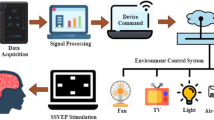Abstract
In this study, we proposed a wireless brain–computer interface (BCI) with steady-state visually evoked potentials (SSVEP) to control several devices in a smart living space for paralyzed patients. In this system, we used electroencephalography (EEG) acquisition chip to extract SSVEPs from EEG signals and transform them by using of FFT into frequency domain. Then, these SSVEPs can be converted into commands to control several devices such as lights, television, air-condition, electric bed, wheelchair, and short message services through a Bluetooth on a mobile device for patients. In this system, several flickering patterns with different frequencies were generated. NeuroSky EEG chips were used to capture EEG signals from locations Oz and FP2. The patients gazed these flickering patterns to generate SSVEPs, and then these SSVEPs were extracted from location Oz on their occipital lobe. Additionally, eye-winking signal was captured from location FP2 on forehead to generate an emergency command. Then these signals can be transformed by FFT into frequency domain and then transmitted to the hardware through Bluetooth interface. The advantages of the proposed BCI system are low cost, low power consumption and compact size so that the system can be suitable for the paralytic patients. The experimental results showed that feasible actions can be obtained for the proposed BCI system and control circuit with a practical operating in a smart living space for paralyzed patients.



















Similar content being viewed by others
References
Ullah, K., Rizwan, M., Ali, M., & Imran, M., (2011). Low-cost single-channel eeg based communication system for people with lock-in syndrome. In IEEE 14th international multitopic conference (pp. 120–125).
Liavas, A. P., Moustakides, G. V., Henning, G., Psarakis, E. Z., & Husar, P. (1998). A periodogram-based method for the detection of steady-state visually evoked potentials. IEEE Transactions on Biomedical Engineering, 45(2), 242–248.
Wang, Y., Gao, X., Hong, B., Jia, C., & Gao, S. (2008). Brain–computer interfaces based on visual evoked potentials. IEEE Engineering in Medicine and Biology Magazine, 27(5), 64–71.
Bin, G., Gao, X., Wang, Y., Li, Y., Hong, B., & Gao, S. (2011). A high-speed BCI based on code modulation VEP. Journal of Neural Engineering. doi:10.1088/1741-2560/8/2/025015.
Chang, H.-C., Deng, H.-T., Lee, P.-L., Wu, C.-H., & Shyu, K.-K., (2010). Real-time control of an SSVEP-actuated remote-controlled car. In SICE annual conference (pp. 1884–1887).
Wang, H., Li, T., & Huang, Z., (2010). Remote control of an electrical car with SSVEP-Based BCI. In IEEE international conference on information theory and information security (pp. 837–840).
Wu, H.-Y., Lee, P.-L., Chang, H.-C., & Hsieh, J.-C. (2011). Accounting for phase drifts in SSVEP-based BCIs by means of biphasic stimulation. IEEE Transactions on Biomedical Engineering, 58, 1394–1402.
Ortner, R., Allison, B. Z., Korisek, G., Gaggl, H., & Pfurtscheller, G. (2011). An SSVEP BCI to control a hand orthosis for persons with tetraplegia. IEEE Transactions on Neural Systems and Rehabilitation Engineering, 19, 1–5.
Lin, J.-S., & Yang, W.-C. (2012). Wireless brain–computer interface for electric wheelchairs with eeg and eye-blinking signals. International Journal of Innovative Computing, Information and Control, 8(9), 6011–6024.
Lin, J.-S., & Huang, S. M. (2013). An FPGA-based brain–computer interface for wireless electric wheelchairs. Applied Mechanics and Materials, 284–287, 1616–1621.
Shyu, K.-K., Chiu, Y.-J., Lee, P.-L., Lee, M.-H., Sie, J.-J., Wu, C.-H., et al. (2013). Total design of an FPGA-based brain–computer interface control hospital bed nursing system. IEEE Transactions on Industrial Electronics, 60(7), 2731–2739.
Wolpaw, J. R., Birbaumer, N., McFarland, D. J., Pfurtscheller, G., & Vaughan, T. M. (2002). Brain–computer interfaces for communication and control. Clinical Neurophysiology, 113, 67–79.
Acknowledgments
In this paper, the research was sponsored by the National Science Council of Taiwan under the Grants NSC102-2221-E-167-032 and NSC103-2221-E-167-027.
Author information
Authors and Affiliations
Corresponding author
Rights and permissions
About this article
Cite this article
Lin, JS., Hsieh, CH. A Wireless BCI-Controlled Integration System in Smart Living Space for Patients. Wireless Pers Commun 88, 395–412 (2016). https://doi.org/10.1007/s11277-015-3129-0
Published:
Issue Date:
DOI: https://doi.org/10.1007/s11277-015-3129-0




